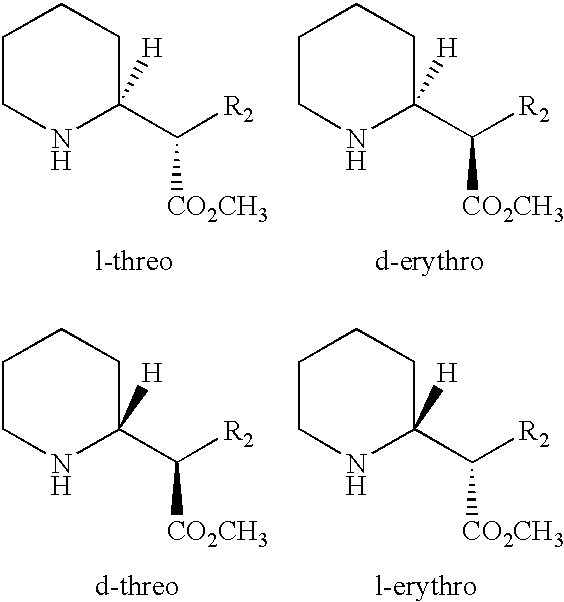Methods for treatment of cognitive and menopausal disorders with D-threo methylphenidate
a technology of dthreomethylphenidate and cognitive and menopausal disorders, which is applied in the direction of biocide, drug composition, metabolic disorders, etc., can solve the problems of inability to achieve the effects of reducing cognitive function, reducing cognitive function, and reducing pain
- Summary
- Abstract
- Description
- Claims
- Application Information
AI Technical Summary
Benefits of technology
Problems solved by technology
Method used
Image
Examples
example 1
Administration of D-threo-methylphenidate Hydrochloride (d-MPH) in the Treatment of Cognitive Dysfunction Related to Chemotherapy in Adult Cancer Patients
[0060]Patients that have received at least one cycle of cytotoxic chemotherapy, preferably within 2 months prior to treatment, and who display one or more symptoms of cognitive dysfunction are evaluated as candidates for d-MPH treatment. Prior to commencement of treatment, patients are evaluated for the following: medical history / concomitant illnesses, physical examination, 12-lead electrocardiogram, routine laboratory tests and assessments of cognitive function. Tests for cognitive function can include those know to those of skill in the art, for example those described above. Patients having no medical contraindication to the use of methylphenidate are then initially administered d-MPH 5 mg / day (2.5 mg b.i.d given 4 to 6 hours apart). The dose may be increased as clinically warranted if there are no adverse effects that preclude ...
example 2
Administration of D-threo-methylphenidate Hydrochloride (d-MPH) in the Treatment of Menopausal Women
[0062]Menopausal women who display one or more symptoms including an executive function defect, decreased cognitive function, mental depression, vasomotor instability, nervousness, excitability, fatigue, neurobehavioral slowing, apathy, or impairment of short term memory are evaluated as candidates for d-MPH treatment. Prior to commencement of treatment, patients are evaluated for the following: medical history / concomitant illnesses, physical examination, 12-lead electrocardiogram, routine laboratory tests and assessments of the severity of the symptom.
[0063]Patients having no medical contraindication to the use of methylphenidate are then initially administered d-MPH 5 mg / day (2.5 mg b.i.d given 4 to 6 hours apart). The dose may be increased as clinically warranted if there are no adverse effects that preclude dose-escalation and there is no significant therapeutic response. Daily do...
example 3
Administration of D-threo-methylphenidate hydrochloride (d-MPH) in the Treatment of Menopausal Women Having Previously Diagnosed Attention Deficit Disorder (ADD)
[0065]Menopausal women who have been previously been diagnosed with Attention Deficit Disorder (“ADD”) and who are suspected having exacerbated ADD symptoms are evaluated for one or more symptoms of ADD according to previously published methods (for example, see American Psychiatric Association. Diagnostic and Statistical Manual of Mental Disorders, Fourth Edition (DSM-IV). Washington, D.C., 1994, pp 78-85).
[0066]Patients having no medical contraindication to the use of methylphenidate are then initially administered d-MPH 5 mg / day (2.5 mg b.i.d given 4 to 6 hours apart). The dose may be increased as clinically warranted if there are no adverse effects that preclude dose-escalation and there is no significant therapeutic response. Daily doses can be administered two or three times per day. The maximum dose will generally be ...
PUM
| Property | Measurement | Unit |
|---|---|---|
| time | aaaaa | aaaaa |
| time period | aaaaa | aaaaa |
| weight | aaaaa | aaaaa |
Abstract
Description
Claims
Application Information
 Login to View More
Login to View More - R&D
- Intellectual Property
- Life Sciences
- Materials
- Tech Scout
- Unparalleled Data Quality
- Higher Quality Content
- 60% Fewer Hallucinations
Browse by: Latest US Patents, China's latest patents, Technical Efficacy Thesaurus, Application Domain, Technology Topic, Popular Technical Reports.
© 2025 PatSnap. All rights reserved.Legal|Privacy policy|Modern Slavery Act Transparency Statement|Sitemap|About US| Contact US: help@patsnap.com



